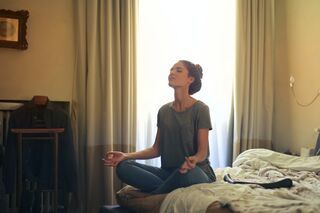Meditation
Why Successful People Meditate
Part 2 of my interview with Dan Harris
Posted March 24, 2021 Reviewed by Matt Huston

Have you ever wondered how celebrities deal with anxiety? As a psychologist who works with a fair number of celebrities and other people who are just really "on top of their game," I have observed that they actually do seem to process anxiety a little differently. One of the biggest differences is that they often know how to turn the anxiety into a source of energy rather than seeing it as purely an obstacle.
I was uber-thrilled when ABC News anchor and author Dan Harris (whom I have never treated for anxiety) agreed to answer a few of my questions on how he handles anxiety. Here is Part 2 of our interview! (See Part 1 here.)
One of your books, Meditation for Fidgety Skeptics: A 10% Happier How-To Book, focuses on addressing meditation skeptics. What would you say to CEOs, entrepreneurs, and other executives who are experiencing panic and anxiety at work, but are reluctant to try out meditation?
There are any number of reasons why people may be reluctant. The answer to that is, take a look at the science. It isn't dispositive. The science around meditation and mindfulness is a reasonably young field. But it strongly suggests that meditation can produce a tantalizingly long list of health benefits: that it can reduce blood pressure, boost your immune system, and re-wire key parts of the brain associated with attention, self-awareness, compassion, and stress. That's pretty compelling.
Further, take a look at all the successful people who are doing it. Athletes such as the Chicago Cubs. Entertainers from 50 Cent to Lena Dunham and Katy Perry. Executives from the head of Twitter to folks at Google. Lawyers, journalists, politicians—you name it. Very successful people are using meditation as a tool.
Another reason executives may be skeptical is that they're worried about time. I’m sympathetic to the fact that we all feel a sense of time starvation. I have two mantras that I pair for this. One is "one minute counts." Everybody wants to know what the least amount of mediation is they can do and still derive the advertised benefits. I've talked to a lot of scientists about this and while there is no proven answer, I've been able to generate something of a consensus that if you did 5-10 minutes a day you'd be in the right zone. That being said, I recognize that doing 5-10 minutes every day is a tall order, especially at the beginning. That’s why I like to say one minute counts. What are we doing in meditation? We're developing a deeper familiarity with this inner narrator or voice in our head, this non-stop conversation that we're having which, when we don't see it clearly, owns us. You can do that in a minute.
What we know from habit formation is that starting small is a really effective strategy. Another thing that we know from habit formation is that having flexibility, a sense of elasticity, can really help. This gets to my second mantra: I like to recommend daily-ish. If you tell yourself you're going to do it every day, the first time you miss a day the voice in your head is going to swoop in and tell you that you're a failed meditator. If you say daily-ish, then you can do your best to do it as many days as you possibly can.
Another area of reluctance is people believe they will lose their edge if they start meditating. There’s a belief you'll become a passive, zenned-out, permanently blissful blob. It's an overly optimistic view of meditation. I wish this were the case! I would certainly be permanently happy but less effective at work. That's not on offer here; there are no silver bullets. Meditation isn't going to make anyone all of a sudden like those statues at the airport spas that are blissfully floating off into the universe. Meditation is a mental exercise that over time improves qualities that we all want, such as focus, gratitude, connection, emotional awareness, and emotional intelligence. These are all things that when improved, will increase your edge, not reduce it.
Again, I harken back to all the incredibly successful people who are doing meditation—it hasn't reduced their edge. This is the central argument that I make in my little side hustle as a meditation evangelical—that the mind is trainable. All of the qualities that we don't like about ourselves, these are not factory settings that are unalterable. They are actually things we can change and skills we can develop, and that's the radical good news that science is showing us about meditation, so go for it.
The Ten Percent Happier app provides a resource for people looking for guided meditations. Along with that, what are some meditation techniques that can be discreetly applied during the day for folks battling anxiety at work?
Off the top of my head, there are four techniques I find to be useful:
1. This is really simple and to the point of being a cliche, but things become cliche because they're true. Taking a deep breath is incredibly useful. It resets the nervous system in a really helpful way. I do find myself taking deep breaths on the regular, especially if I'm heading into or find myself in the middle of a stressful situation.
2. Turn activities that normally would be opportunities for mindlessness into opportunities for mindfulness. Walking from one place to the next, walking from one meeting to the next, or now, just walking from one room to the next. Instead of using it as a time to multitask and check your email, or think up a glorious, profanity-laced speech you're going to deliver to your boss, drop into what it feels like in your body—the legs and arms moving, perhaps the body breathing. This is a really useful way to get yourself out of your head and into your body. It stops this kind of mindless momentum, this stuckness in your own stories, this blind, headlong topple and forward that we often experience during the day. Don't expect that you're going to do this one and be perfect at it. That's not what's going to happen. You'll pay attention to your legs and then you'll reach for your phone. The whole goal is to notice when you get distracted from what you're intending to focus on and then start again and again and again.
3. Try to notice rushing, particularly little moments where you're rushing. You can rush even when you're moving slowly and you can move quickly without rushing. Notice when you are in some ways uncomfortable in the present moment and you're just trying to get to the next thing. This is just a really useful thing to tune into. When you see it, you don't have to beat yourself up—just use that as a moment to wake up, take a deep breath, and re-set. Once you start looking for rushing, you'll notice it over and over again.
4. At work, whether you're in an office or working from home like many of us, you can still step away from the desk. This is easy to do if you’re at home, and one of the perks of working from home. Do a quick meditation during the day—2 to 5 minutes. Use an app, don't use an app, whatever. This quick meditation is another way to pull yourself out of the traffic and gain some increased common perspective, instead of just being sucked along in this kind of river of mindlessness that consumes so many of us, myself included.
Would you like to try meditating right now? Here is a free video of one of my favorite techniques!




